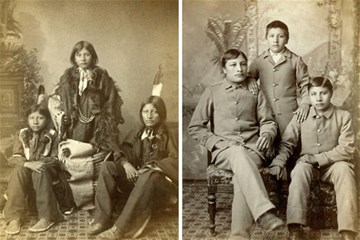As a member of the New England Conference Committee on Native American Ministries (CONAM) , I get to attend regional meetings. In 2018, our yearly meeting was held in Carlisle, PA.
Your gifts on Native American Ministries Sunday helps support the ministries of the Committee on Native American Ministries in their annual conferences. This offering serves to remind United Methodists of the gifts and contributions made by Native Americans to our society.
I knew we were going to tour the Carlisle Barracks, which is where the Carlisle Indian School was located in the late 1800's through early 1900's.
For those who don't know, Indian boarding schools were seen as a way to deal with the Indian "problem." Between 1880 and 1902, 25 off-reservation boarding schools were built; 20,000 to 30,000 Native American children went through the system. That was roughly 10 percent of the total Indian population in 1900. The Carlisle Indian School in Pennsylvania was the most notable of these institutions.
It began when Army Lt. Richard Henry Pratt was in charge of 72 Indian prisoners who had been fighting the Army in the southern plains.
Pratt transported these Cheyenne, Arapaho, Kiowa, Comanche and Caddo prisoners halfway across the continent to St. Augustine, Florida. (Ironically, St. Augustine was the first Spanish settlement in North America.)
It was a terrifying experience for the transplanted Indians.
By April 1878, 62 of the younger, more easily educated Indians joined the Hampton Institute in Virginia – a "normal school" or teacher-training institute founded by abolitionists for blacks.
The experiment seemed to work. Pratt's "savage warriors" were on their way to becoming teachers. Pratt publicized the success of the experiment through a series of "then-and-now" photos showing the "savage" versus the "civilized" Indians.
Pratt coined the phrase "Kill the Indian, save the man."
Pratt convinced parents and tribal elders to send their children by train to a far-off place. Pratt believed this would break the students quicker of their ties to their traditions.
Students were prohibited from speaking their native languages. Instead, they were supposed to converse and even think in English.
If they were caught "speaking Indian," they would be severely beaten with a leather belt. Visiting the grounds at Carlisle was an emotional experience for me. I could feel the presence of those who went here.
We toured the Hessian Powder Magazine, a small brick structure, which some Indians were held in solitary confinement.
We toured the parade grounds and saw photos of different trade classes from that era.
At the end of our tour, we visited the graveyard where some of the Indian children were re-buried from elsewhere on the base.
Words cannot properly describe the emotions that washed over me when we were in that graveyard. We had some tobacco to spread and I prayed over several stones.
Andrew Windyboy (Cree) was interviewed in 2008 and his interview is available on YouTube.
I recommend watching it to hear the story from someone who went through the school.
Todd Warfield, New England Conference, Committee on Native American Ministries (CONAM).
One of six churchwide Special Sundays with offerings of The United Methodist Church, Native American Ministries Sunday serves to remind United Methodists of the gifts and contributions made by Native Americans to our society. The special offering supports Native American outreach within annual conferences and across the United States and provides seminary scholarships for Native Americans.
When you give generously on Native American Ministries Sunday, you equip seminary students who will honor and celebrate Native American culture in their ministries. You empower congregations to find fresh, new ways to minister to their communities with Christ's love. Give now.





